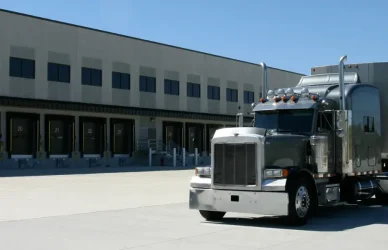A groundbreaking technology company, Ten5 Inc., has entered the trucking industry, introducing an innovative communication tool designed to enhance driver safety and retention. The company’s hands-free voice assistant leverages proprietary voice technology and artificial intelligence to facilitate secure communication between drivers and fleet back offices while on the road.
CEO Drew Ryder highlighted the shortcomings of current fleet communication methods, predominantly text-based or phone calls, citing their inefficiency and potential distractions. Ten5’s voice platform eliminates these barriers, providing a streamlined communication experience for drivers.
“The main goal here was that we wanted to make it completely hands-free with no level of distraction so they’re not having to look down at the device and touch things,” Ryder said.
Accessible through an app on any Android device, such as a tablet with an ELD in the truck’s cab, the voice platform is activated with a simple “Hey Ten5” command, akin to popular voice assistants like Alexa or Siri. Drivers can then specify the message type – urgent, comment, or complaint – and articulate their message. The platform, detecting the completion of the message, replays it and seeks confirmation for sending.
Once a driver sends a message, it reaches the dispatcher or fleet manager, who can respond or forward it to relevant administrators like safety directors, maintenance managers, or HR personnel. Back-office staff can access the platform via a web browser, requiring only a computer with a microphone and speaker.
Addressing the challenge of managing large groups of drivers assigned to a single dispatcher, Ten5’s platform offers two fleet-initiated communication methods: direct messages to a single driver or broadcast messages to a group of drivers. This addresses communication gaps that can lead to safety and retention issues.
“If I’ve got 50 drivers and 10 of those all wanted something from me at the same time, they’re going to get frustrated because you can’t get to all 10 at the same time,” Ryder said.
The platform categorizes messages into urgent, comment, or complaint, enabling fleet managers to prioritize responses. It provides analytics on message types, recording reception times and issue resolution durations. Ryder emphasized the platform’s value in maintaining the chain of custody for messages, ensuring promises made to drivers are visible and facilitating better organization and access to conversations.
“That for us is a key metric in driver satisfaction and reducing frustration because from everything we’re seeing and hearing, the main reason drivers are leaving fleets is because they just don’t feel they’re being heard; if they have a concern, it’s not being acknowledged enough, and there’s no communication,” Ryder said. “If the driver has said something, and a promise was made to them, that’s all available for everyone to see, and now there’s less, ‘I forgot about that. I didn’t get to that’ because the platform enables managers to be more organized with better access to conversations.”
Beyond improving retention by fostering a sense of team inclusion and issue resolution, the platform enhances safety through its entirely hands-free design. Evidence suggests that frustrated drivers are less safe, exhibiting more aggressive behavior and reduced care for equipment and customer service. The platform’s broadcast communication method allows fleets to send mass messages on safety, fuel efficiency, traffic alerts, or company-wide bulletins. It also enables scheduled messages, surveys, and aggregated response reports.
“We humanize the connection with the driver and fleet management,” he said. “We believe voice is a critical method for communication because it’s very personal, particularly if it’s in the voice of a leader. We convey a lot more than just words with voice. There’s also emotion; people can pick up on nuances.”
Furthermore, Ten5’s platform aids in connecting fleets with new drivers, allowing back-office staff to send personalized or mass messages throughout the crucial first 90 days of employment. This proactive engagement helps reduce turnover, and drivers can respond to these messages.
Ryder highlighted the platform’s potential for expansion and evolution based on fleet feedback, emphasizing its capacity for deeper analysis of daily conversations.
“Our voice experience right now is pretty basic; it just messages back and forth,” he said. “To do some of that analysis that I referred to earlier, we’re essentially building this domain-specific large language model behind it with the idea being that whether you’re a driver or a back-office person, you can simply query that to get an answer to a question … and it just will allow faster access to information so they can make decisions.”
While planning aggressive product enhancements, Ten5 aims to stay within the communication and business intelligence segment of the trucking industry.
Source: Commercial Carrier Journal











